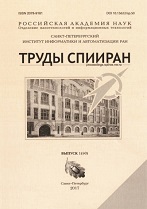|
|
Trudy SPIIRAN, 2009, Issue 11, Pages 63–80
(Mi trspy47)
|
 |
|
 |
This article is cited in 3 scientific papers (total in 3 papers)
Effects of techno-organizational systems functioning estimation: concept of automation
A. S. Geida
St. Petersburg Institute for Informatics and Automation of RAS
Abstract:
The class of techno-organizational systems research problems considered. Techno-organizational systems are differing in that they have maintained technical devices and the people functioning according to instructions in their structure.
It is shown that estimation of techno-organizational systems functioning effects should be a basis for the successful decision of problems mentioned.
Estimation of effects is carried out with use of techno-organizational systems models and models of processes of their functioning.
A number of practical features of such models construction considered, necessity of needed models construction automation is shown. Problem formulation of automated modeling for estimation of effects is carried out.
The review of modeling automation software, used for various problems solving with techno-organizational systems provided.
Lacks of existing software, intended for modeling at various technoorganizational systems problems solving are analyzed.
Principles of automated modeling by use of graph-theoretic models are offered.
Principles of automated modeling offered and the statement of a problem carried out have allowed to develop the concept of software construction for modeling automation.
Use case schema of software for automated modeling by use of graph-theoretic models is considered.
The example of automated modeling software project, based on offered principles and schema is considered. The concept of the automated modeling in effects estimating problems (EEP) developed allows starting software projects with goal to create applications for automated modeling during EEP solving.
Such software projects should allow to automate modeling of technoorganizational systems (TOS) functioning, and as a result, to estimate its effects.
They shall be a basis for estimation of efficiency of TOS functioning, risk, TOS potential, TOS safety, which have the major value at TOS research processes. For practical use at modern TSO the concept should be expanded with usage of hypergraphs, metagraphs and other structural models alike.
The concept can be expanded further at the expense of use of other models, especially ones allowing to estimate not only techno-organizational systems effects of functioning, but also organizational, social and economic systems effects of functioning.
Keywords:
effects, techno-organizational systems, functioning, modeling automation, software, graph theory, software use case.
Received: 09.12.2009
Citation:
A. S. Geida, “Effects of techno-organizational systems functioning estimation: concept of automation”, Tr. SPIIRAN, 11 (2009), 63–80
Linking options:
https://www.mathnet.ru/eng/trspy47 https://www.mathnet.ru/eng/trspy/v11/p63
|

| Statistics & downloads: |
| Abstract page: | 763 | | Full-text PDF : | 260 | | References: | 1 | | First page: | 1 |
|




 Contact us:
Contact us: Terms of Use
Terms of Use
 Registration to the website
Registration to the website Logotypes
Logotypes








 Citation in format
Citation in format 
